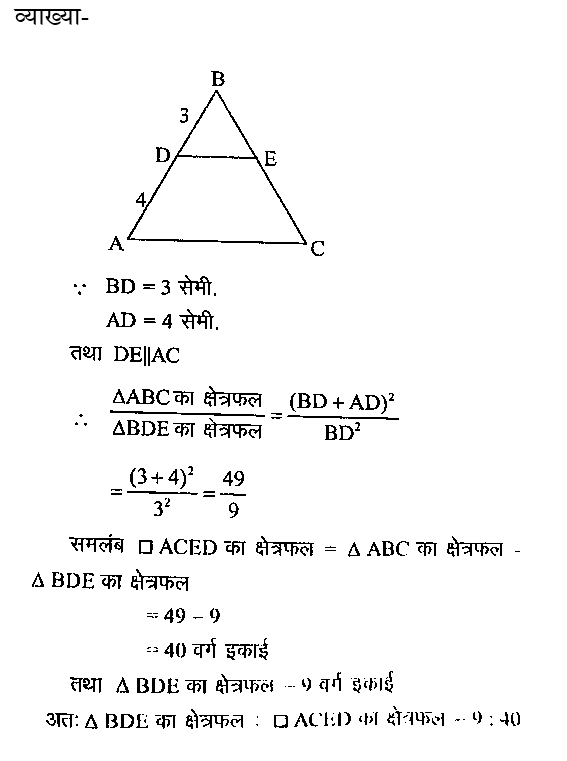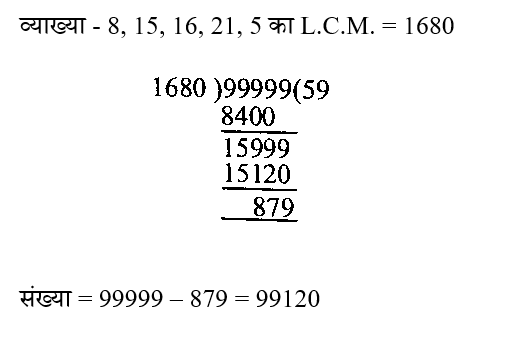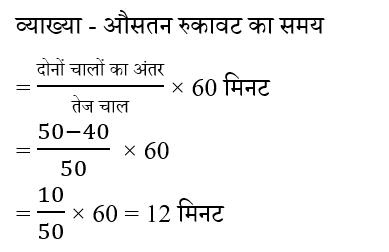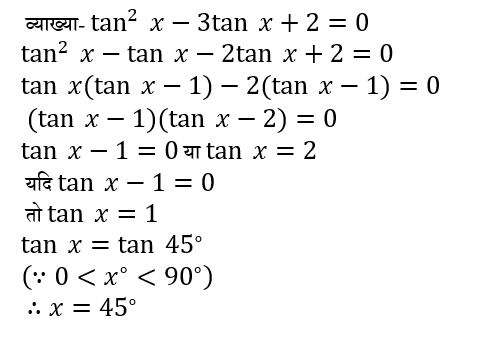Question 1:
In ∆ABC, D is a point on side AB such that BD = 3 cm and DA = 4 cm. E is a point on BC such that DE || AC. Area of ∆BDE : Find the area of trapezium ACED.
∆ABC में, भुजा AB पर बिंदु D इस प्रकार है कि BD = 3 सेमी. और DA = 4 सेमी. है। BC पर बिंदु E इस प्रकार है कि DE || AC है | ∆BDE का क्षेत्रफल : समलंब चतुर्भुज ACED का क्षेत्रफल का मान ज्ञात करें।
Question 2: 
Question 3:
Which of the following is the largest five-digit number which is exactly divisible by 8, 15, 16, 21 and 5?
8, 15, 16, 21 और 5 से पूरी तरह से विभाज्य होने वाली सबसे बड़ी पांच- अंकीय संख्या निम्न में से कौन-सी है ?
Question 4:
If the six-digit number 5z3x4y is divisible by 7, 11 and 13, then find the value of (x + y – z).
यदि छ: अंक वाली संख्या 5z3x4y, 7, 11 और 13 से विभाज्य है, तो (x + y – z) का मान ज्ञात करें।
Question 5:
4/5 of a number is 12 more than its 3/4. Find that number.
एक संख्या का 4/5 भाग उसके 3/4 भाग से 12 अधिक है । वह संख्या ज्ञात कीजिए।
Question 6:
A shopkeeper buys two books for Rs 300. He sells the first book at a profit of 20% and the second book at a loss of 10%. If there is neither profit nor loss in the entire transaction, then what will be the selling price of the first book?
एक दुकानदार 300 रु. में दो पुस्तक खरीदता है। वह पहली पुस्तक को 20% के लाभ पर तथा दूसरी पुस्तक को 10% हानि पर बेचता है। यदि पूरे लेन-देन में न लाभ होता है और न ही हानि, तो पहली पुस्तक का विक्रय मूल्य क्या होगा ?
Question 7:
The price of diesel increases by 16%. A person wants to increase his diesel expenditure by only 10%. By what percent (correct to one decimal place) must he reduce his consumption?
डीजल की कीमत में 16% की वृद्धि होती है। एक व्यक्ति अपने डीजल के व्यय में केवल 10% की वृद्धि करना चाहता है। उसे अपनी खपत को कितने प्रतिशत (दशमलव के एक स्थान तक शुद्ध) कम करना होगा ?
Question 8:
Two numbers are in the ratio 9 : 7. If the larger number is 56 more than one-seventh of the smaller number, what is the sum of those two numbers?
दो संख्याएं 9:7 के अनुपात में हैं। यदि बड़ी संख्या, छोटी संख्या के एक- सातवें से 56 अधिक है, तो उन दो संख्याओं का योग क्या है ?
Question 9:
A train travels at an average speed of 50 km/hr without stoppages and 40 km/hr with stoppages. For how many minutes per hour does the train stop on an average?
एक रेलगाड़ी बिना रुके (स्टॉपेज) 50 किमी / घंटा की औसत गति से और रुकने के साथ 40 किमी./घंटा की औसत गति से चलती है। रेलगाड़ी, औसतन प्रति घंटा कितने मिनट रुकती ?
Question 10: 









